Some things about bats
This entry of mine will be about bats. I hope you will be highly interested in:)
Don't think badly about bats - these only flying mammals!:)
I have found these all info on the Net.
A lot of bats are under protection. Don't disturb them, please:)
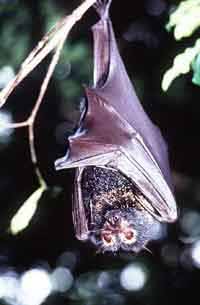
Bats are winged mammals of the order Chiroptera, which includes 900–1,000 species classified in about 200 genera and 17 families. Bats range in size from a wingspread of over 5 ft (150 cm) to a wingspread of less than 2 in. (5 cm). They are found in nearly all parts of the world but are most numerous in the tropics; there are about 39 species in the United States. Most bats are economically valuable because of the large number of insects they consume.
The body of the bat is mouselike and usually covered with fine fur. The face varies greatly from one species to another; many species have complex appendages on the snout and projections, or false ears, in front of the true ears; the ears themselves are often very large and elaborately convoluted. These facial structures are part of the sensory apparatus that emits and receives sound vibrations.
Some bats are solitary, living in caves, crevices, hollow trees, or attics; other species are communal, with thousands or even millions of bats roosting together in a cave or on branches in a section of forest. In some species of communal bats, the entire colony leaves the roost together in the evening and returns together in the morning; in others, individuals come and go at different times. Bats of northern regions migrate, hibernate, or both in winter.
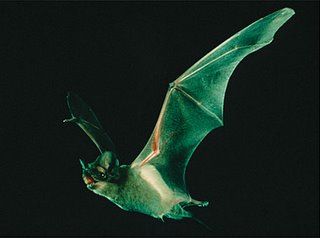
Bat Flight
Bats are the only mammals capable of true flight, that is, flight powered by muscular movement as distinct from gliding. The wing is a double membrane of skin stretched between the enormously elongated bones of four fingers and extending along the body from the forelimbs to the hind limbs and from there to the tail. The thumb is small, clawed, and free from the membrane. The hind limbs are small and may be rotated in such a way that the knees bend backward rather than forward, as in other mammals; this is presumably an adaptation for takeoff and flight. Bats at rest hang head down, grasping a twig or crevice with their clawed feet; they take off into flight from this position.
Echolocation
Habits and Behavior
Bats vary in social structure, with some bats leading a solitary life and others living in caves colonized by more than a million bats. The fission-fusion social structure is seen among several species of bats. The fusion part is all the individuals in a roosting area. The fission part is the breaking apart and mixing of subgroups by switching roosts with bats, ending up with bats in different trees and often with different roostmates. Studies also show that bats make all kinds of sounds to communicate with each other. Scientists in the field have listened to bats and have been able to identify some sounds with some behavior bats will make right after the sounds are made.
ReproductionMother bats usually have only one offspring per year. A baby bat is referred to as a pup. Pups are usually left in the roost when they are not nursing. However, a newborn bat can cling to the fur of the mother and be transported, although they soon grow too large for this. It would be difficult for an adult bat to carry more than one young, but normally only one young is born. Bats often form nursery roosts, with many females giving birth in the same area, be it a cave, a tree hole, or a cavity in a building. Mother bats are able to find their young in huge colonies of millions of other pups. Pups have even been seen to feed on other mothers' milk if their mother is dry. Only the mother cares for the young, and there is no continuous partnership with male bats. The ability to fly is congenital, but after birth the wings are too small to fly. Young microbats become independent at the age of 6 to 8 weeks, megabats not until they are four months old. At the age of two years bats are sexually mature.
Myth 2: Bats get tangled in your hair.
In fact, Tuttle has tried to make this happen, but bats just won’t tangle. He notes that echolocation, their sophisticated sonar system, allows bats to dodge wires as fine as human hairs—in the dark.
Myth 3: Bats are rabid attackers of humans.
Bats are actually clean, meticulous groomers. They can contract rabies like most mammals, but as Tuttle advises, “you rarely have to worry about a sick bat if you just leave them alone and go about your business.” In 40 years of studying bats, he’s never been attacked or harmed by one.
Myth 4: Bats are bloodsuckers.
Most bats are nocturnal and eat insects. Some eat fruit, and a few are predators of small vertebrates. Only three of the one thousand or so bat species ingest blood. They live only in Latin America, and only one feeds on livestock while the others feed on the blood of birds.
Myth 5: Bats are rodents.
Bats are no more related to rodents than humans are. Evolution studies show that bats are more
closely related to primates than to rodents.
On this, Tuttle responds: “Realistically, there’s nothing more ugly than an elephant. Its eyes are too small, its nose too long, its ears too big. It’s heavy. But we love them, and that’s because we understand them.” Along those same lines, he mentions that photographing bats as they are most of the time—instead of in defensive, snarling positions—has greatly improved their image. “Many are cute, and all are fascinating,” Tuttle says.
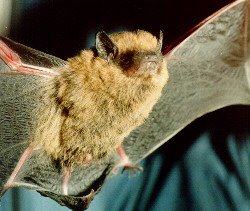
In Western Culture, the bat is often a symbol of the night and its forboding nature. The bat is a primary animal associated with fictional characters of the night such as both villains like Dracula and heroes like Batman. The association of the fear of the night with the animal was treated as a literary challenge by Kenneth Oppel, who created a best selling series of novels, beginning with Silverwing, which feature bats as the central heroic figures much in a similar manner as the classic novel Watership Down did for rabbits. An old wives' tale has it that bats will entangle themselves in people's hair. A likely root to this myth is that insect-eating bats seeking prey may dive erratically toward people, who attract mosquitoes and gnats, leading the squeamish to believe that the bats are trying to get in their hair.
In the United Kingdom all bats are protected under the Wildlife and Countryside Acts, and even disturbing a bat or its roost can be punished with a heavy fine.
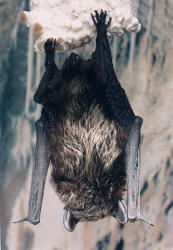
Last but not least
Most microbats are active at night or at twilight, so the eyes of most species of microbats are poorly developed. Their senses of smell and hearing, however, are excellent. By emitting high-pitched sounds and listening to the echoes, the microbats locate prey and other nearby objects. This is the process of echolocation, a skill they share with dolphins and whales.
The teeth of microbats resemble those of the insectivores. They are very sharp in order to bite through the chitin armour of insects or the skin of fruits.
While other mammals have one-way valves only in their veins to prevent the blood from flowing backwards, bats also have the same mechanism in their arteries.
The finger bones of a bat are much more flexible than those of other mammals. One reason is that the cartilage in their fingers lacks calcium and other minerals nearer the tips, increasing their ability to bend without splintering. The cross section of the finger bone is also flattened instead of circular as is the bone in a human finger, making it even more flexible. The skin on their wing membranes is much more elastic and can stretch much more than what is usually seen among mammals.
Because their wings are much thinner than those of birds, bats can maneuver more quickly and more precisely than birds.



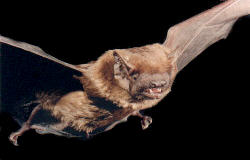

0 Comments:
Post a Comment
<< Home